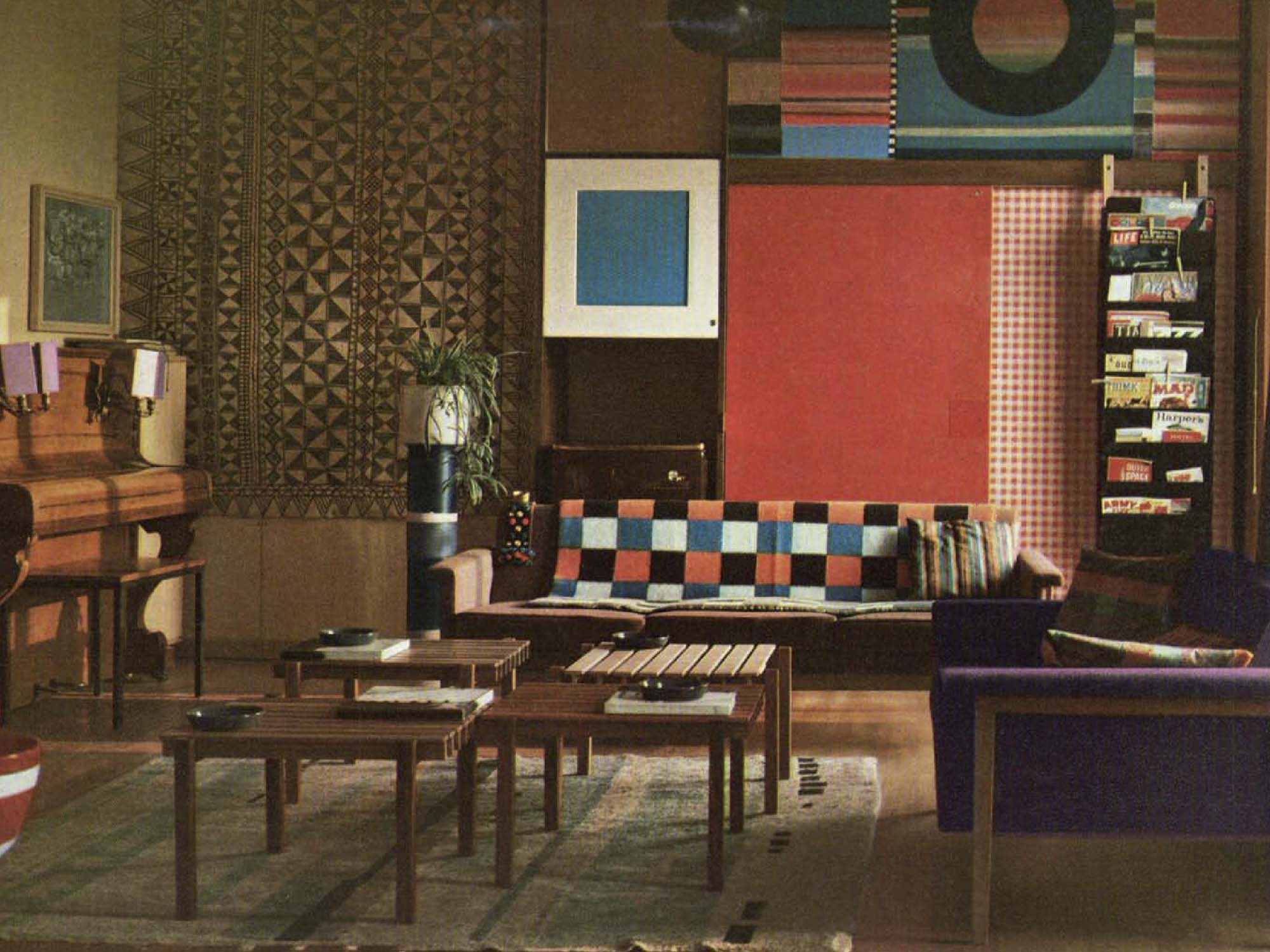By Glenn Adamson
“I have always thought that design begins where rational processes end and magic begins.” – Ettore Sottsass, Jr.
What are the purposes of abstraction? It’s not a question often asked, for art history has tended to see abstraction as an end in itself. In two senses: it is an autonomous sphere of form, cleanly separated from everyday necessity; and also an end in the sense of a destination. In this canonical view, modern abstraction marks a culminating condition for art, in which it discovered its own wings and took flight.
Leave it to Ettore Sottsass, Jr., to see things differently. For him abstraction was certainly a language of liberation. But it was also something instrumental – a lexicon that could be put to work. It was something to be applied – to a potentially infinite range of purposes, from the whole social fabric to the intimate emotional landscape.
Sottsass’s stance, while uniquely generative in the context of design, was not entirely unprecedented. He had a magpie’s mind; he plucked insights from a dizzying array of sources. But he was anything but indiscriminate. He unerringly sought those precedents that had something to teach about abstraction as a means of action in the world – whether ancient, as in the architecture and objects of the Indian subcontinent and Mesoamerica, or modern, as in the hybrid practices of the Wiener Werkstätte, the Bauhaus, and the Dutch avant garde movement De Stijl. In all of these, he saw pure geometry, positioned not as transcendental, a realm unto itself, but as a way to saturate everyday life with meaning –in the context of spirituality and utility, brought into alchemical combination.
Sottsass summarized his early years bluntly: “after a happy youth in the mountains and a much less happy youth in various schools I got an architectural degree at the Turin Politecnico in 1939. I was then forced to waste seven years of my life in the Army.”[1] Worse than a waste, in fact: conscripted into the Italian military, he was captured and imprisoned in a labor camp in Sarajevo. At war’s end, he moved to Milan. One of his first projects there was to collaborate with his father on a shop interior, the Negozio Cittone, in Turin; he also created furniture for the interior that Ettore Sottsass, Sr., completed for the store’s owner. An entrance table backed by a vertical display panel for prints shows that Sottsass – he was now thirty, but just starting his career thanks to the lost years of the war – was already paying close attention to emergent modernist design, as is evident from the slim metal legs and the composition of nested rectangles. A related approach can be seen in the coffee table from Sottsass’s own apartment, a relic of his early professional life which also impresses with its austere simplicity, offset by dynamic asymmetry.
Sottsass was actively painting after the war, and while his works in the medium are little known today, they offer a significant insight into his aesthetic development, often closely mirroring his output in other disciplines. His works of the 1950s reinforce the impression of a man who was, in his formative years, highly attuned to prevailing progressive currents. The untitled 1954 canvas shown here is close in spirit to the works of European abstract expressionists like Hans Hartung and George Mathieu, with vigorous, rhythmic mark-making establishing a capacious pictorial space. A related tray, made in the quintessential 1950s material of printed melamine, demonstrates Sottsass’s early interest to use functional objects as a transmission medium – quite literally, “applied art.”
Ultimately though, it was not in the expressionist idiom that Sottsass would find his voice as an abstractionist. Rather, he found a way to adapt an orthogonal vocabulary – related to modernist design precedents, but in a sensibility very much his own – to the creation of a wide variety of useful objects. This vocabulary first emerged in the late 1950s, initially in a series of small-scale but arresting works for the wall. Of particular note is a group of related mirrors, expediently built with rectilinear lengths of timber lashed together with rope. The example included here was the first of the series, which Sottsass retained in his own possession; it relates closely to one made for Arform Gallery, Milan, in 1959. It presages later furniture by Sottsass in its suggestively anthropomorphic profile and in its use of strong color, with solid blocks of red and black playing off the neutral wood.
The realization of these first breakthrough works was coincident with the beginning of an extraordinarily productive collaboration with the furnishing manufacturer Poltronova, which commenced in 1957. We see a crucial pattern emerging, here, in which Sottsass’s work with industrial producers was nurtured by his independent experiments. While the context for his creativity was very different in these two spheres, he skillfully navigated between them, and ultimately influenced his corporate patrons to become more adventurous on his behalf. In the case of Poltronova, the progression begins with seating furniture that is surpassingly elegant, but not strikingly unusual for its time; many Italian and Scandinavian companies at this time produced similarly clean, upholstered volumes sitting within slim wooden frames.
[1] Ettore Sottsass, Jr., “Biographies A & B,” Design Quarterly No. 89 (1973), p. 34.
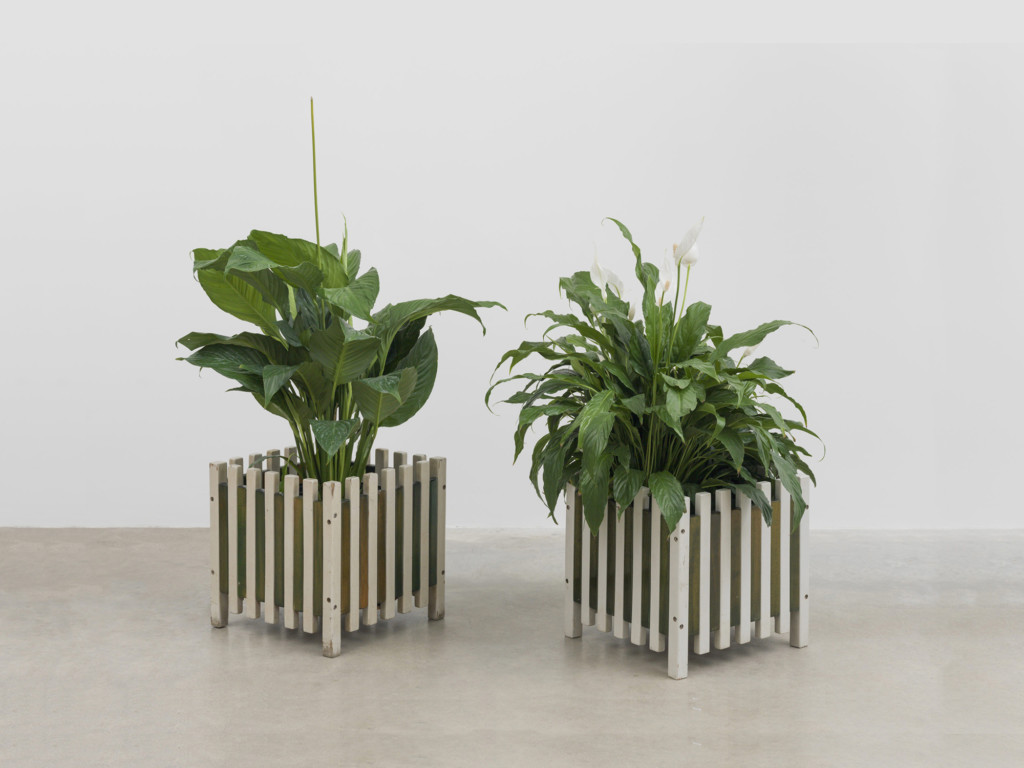
A turning point came with a commission to design an apartment in Ivrea for Nicola Tufarelli, a director at Olivetti, and his wife Germana. Olivetti, of course, was the designer’s most significant corporate client; he would take a leading role in reshaping the company’s products to suit the more active and individualistic consumer product market of the 1960s. The Tufarellis’ apartment was a difficult commission, in that the upper-floor space had to be converted from existing volumes; when the completed project was published in Domus magazine, Sottsass explained that his “first job had been to arrange, according to a certain rhythm, a chaotic mass of constructive elements to make them become architectural elements.” In this unpromising space, he managed to create a miraculously assertive and bold scheme, juxtaposing natural wood and bright color.[2]
The ideas that Sottsass introduced in the Ivrea apartment are also reflected in seating and case pieces he was designing for Poltronova’s product lines at the time. His boldly striped 1962 Califfo sofa (the title alludes to the caliphs, rulers of the Ottoman Empire) follows Wiener Werkstätte precedents in its overall horizontality and slatted, elongated cube construction.[3] Sottsass’s case pieces for Poltronova, meanwhile, may demonstrate a comparable indebtedness to George Nelson, in whose New York design office he had worked for a few months in 1956. While there is nothing in Nelson’s prolific work for Herman Miller quite like Sottsass’s striped-front cabinets and sideboards, the overall formula – a visually eventful but simply constructed form floating atop slender metal legs – is one that Nelson frequently used.
In the succeeding decade, still working as a creative director at Poltronova, Sottsass would completely rethink the basic typologies of case furniture to radical effect. In his celebrated Superboxes (first prototyped in 1966), he thoroughly dismantled the conceptual barrier between sculpture and design, deploying stripes and color blocks (achieved using plastic laminates) so assertively that the cabinet’s function is submerged into its formal presence. As he observed, “color always functions as structure as well.”[4] The first works in which this principle was fully realized were a group of towering, complex cabinets, in which partly enclosed cubical volumes are stacked up to totemic effect. These were made not in a furniture manufactory like Poltronova’s, but rather through a recently formed alliance with the cabinetmaker Renzo Brugola. An under-rated player in the story of Italian radical design, Brugola was a former record store owner with a workshop in Lissone, about ten miles outside of Milan. He met Sottsass in the bohemian atmosphere of the Bar Jamaica in Brera, Milan. There, Brugola’s son Barnabò recalls,
…my father frequented the bar Jamaica in Brera, Milan, where he gathered with workers, artisans, journalists, intellectuals and artists, some of whom would write the history of post-war art. Despite their many different backgrounds, they would all sit together around a table playing cards and discussing anything and everything. [5]
It was an ideal meeting of the minds: in Brugola, Sottsass had found a man who could execute his polymorphous and prolific ideas; in Sottsass, Brugola found a way to expand his own horizons, bringing a world of associations to his Lissone workshop. The two would go on to collaborate for three decades, with Brugola ultimately taking a key (though largely uncredited) role in supporting Sottsass when he founded the radical design group Memphis in 1981.[6]
[2] “In una casa per giovani sposi, all’ultimo piano / Ettore Sottsass jr., arch.,” Domus no. 366 (May 1960), p. 13-18.
[3] Fulvio Ferrari. Mateo Kries and Jochen Eisenbrand, Atlas of Furniture Design (Weil am Rhein, Germany: Vitra Design Museum, 2019), p. 582.
[4] Hans Höger, Ettore Sottsass Jr.: Designer, Artist, Architect (Tübingen; Berlin: Wasmuth Verlag, 1993), p. 78.
[5] Barnabó Brugola, “Renzo and Ettore,” Phillips Auction catalogue, Oct. 18, 2018.
[6] Catharine Rossi, “Making Memphis,” in Glenn Adamson and Jane Pavitt, eds, Postmodernism: Style and Subversion, 1970 to 1990 (London: V&A Publications, 2011).
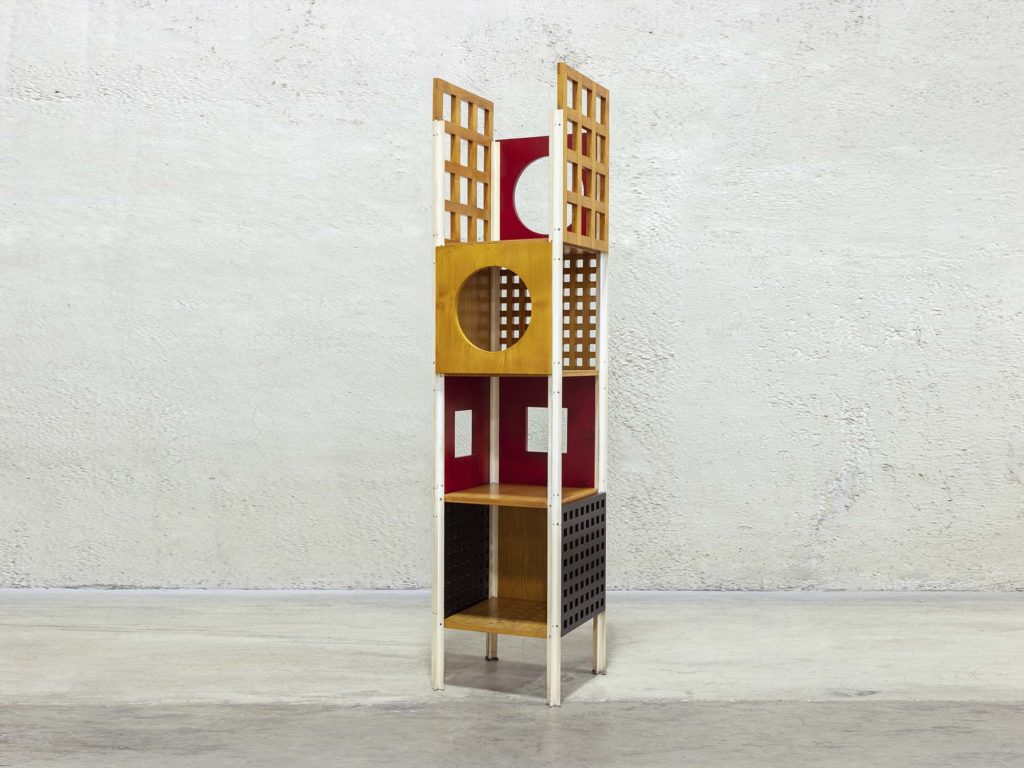
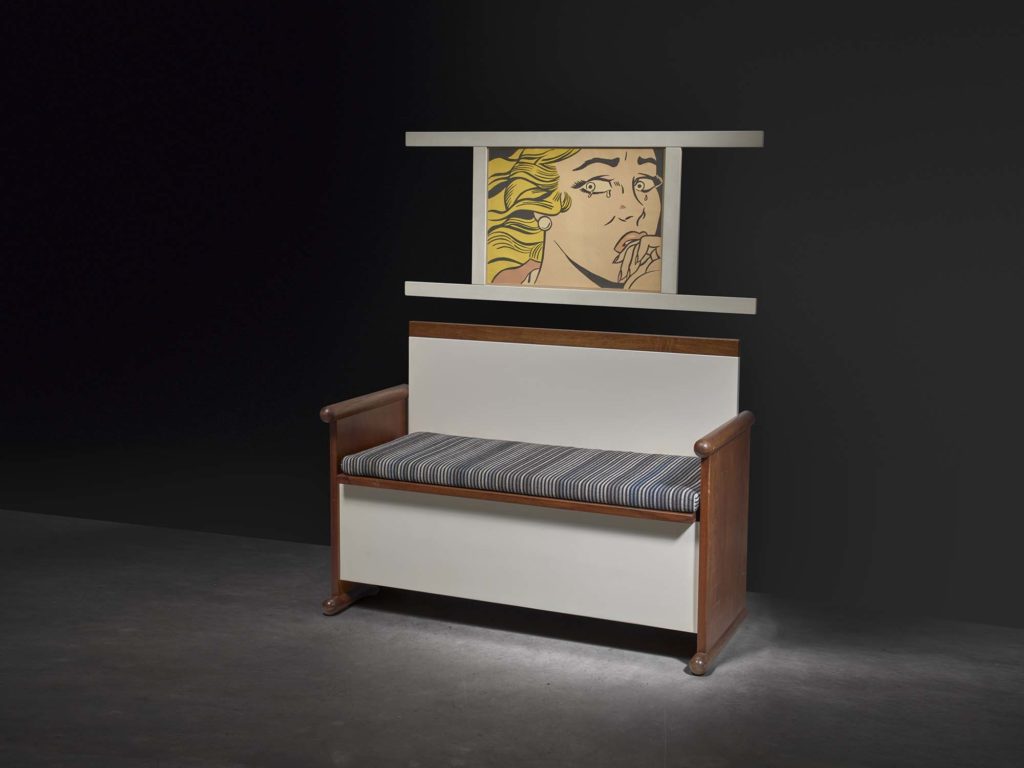
The most important of the two men’s early collaborations is a series of vertical cabinets, including the memorably titled Tower Furniture for the House with the Little Chinese Girl, made for the residence of Mario Tchou, an engineer at Olivetti. Slightly less ornate but no less significant is the Commode Column seen here, of which two were made.[7] The Commode Column has extraordinary movement for a rectilinear object, with squares, circles and grids ricocheting upward fully seven feet from the floor. For all its obvious relatedness to abstract painting and sculpture, there is also something Vitruvian about this geometry, the fundamental harmonies of ancient architecture transposed into a vibrant pop chord.
As the presence of a Roy Lichtenstein print in the current presentation indicates – it passed through the hands of both Leo Castelli and Ileana Sonnabend, and was published in Domus in 1965 – Sottsass was indeed keenly interested in Pop Art as that movement crested.[8] He positioned the print in a wooden frame, one of a series produced with Poltronova in the early 1960s, each one a compact essay in geometric form. In 1964 he published a fascinating essay in Domus magazine entitled “Pop e Non Pop” (“Pop and Non-Pop”), which focused on the work of his fellow Italian Michelangelo Pistoletto, but also reflected on his own recent experiences on trips to New York City. The article is worth quoting at some length:
This youngster named Michelangelo Pistoletto, one cannot say that he is a Pop painter as someone has said, and if someone hasn’t said it, better be clear that this guy has nothing to do with Pop because in Turin, as probably In all of Italy, the premises for Pop painting do not exist, there is only this oppressive and invincible weight, no American Coke, no Vermouth Perlino, no vamps, not much use of deodorant, people still sleep in their pajamas, people still cook pasta, squeeze the tomatoes, people still do all those things. At the Bar Torino on Piazza San Carlo you sit on little baroque chairs to eat lots of gelato but not much “ice-cream.” Thus I would say that this boy from Turin is a true poet, even if perhaps less incisive and caustic than the boys from New York, the Lichtensteins, the Rosenquists, Rauschenbergs, the Oldenburgs, and the Chamberlains, in recounting to us the conditions of our own drama, our own story.[9]
There is more than a hint of self-portraiture in this evocative description. Though Sottsass had moved on from Turin to the more self-consciously modern city of Milan, he clearly empathized with the melancholic atmosphere of Pistoletto’s art, and saw himself similarly floating in the gap between the bracing novelties coming out of America, and the comfortably lived-in street culture of Italy. His use of plastic laminates, in the Superboxes and other projects, was one ingenious way to express this position: at once creating an American-style bright, wipe-clean, artificial surface, while also evoking the countertop of a Milanese sidewalk café. “Certainly there is nothing de luxe about laminated plastic,” as Domus observed in an article about Sottsass’s interiors. “It has no tradition to speak of and few attributes.” It was therefore the ideal material to shape “a big restful room, a sort of void for undoing and leaving outside the door the cases, the purses, the packages and the bags of daily complications, battle fatigue, and let downs.”[10]
[7] The example in the present exhibition was Brugola’s own. The other went to Sottsass’s own apartment, and was retained by his first wife Fernanda Pivano until her passing in 2009; it was shown in the Met Breuer exhibition Ettore Sottsass: Design Radical in 2017.
[8] “Ettore Sottsass Jr.: Mobili 1965 per Poltronova,” Domus 433 (December 1965), p. 35.
[9] Ettore Sottsass Jr., “Pop e non pop: A proposito di Michelangelo Pistoletto,” Domus 414 (May 1964), p. 32-35.
[10] “In a Living-Room: Ettore Sottsass, Architetto, Milano,” Domus 446 (January 1966), p. 26.
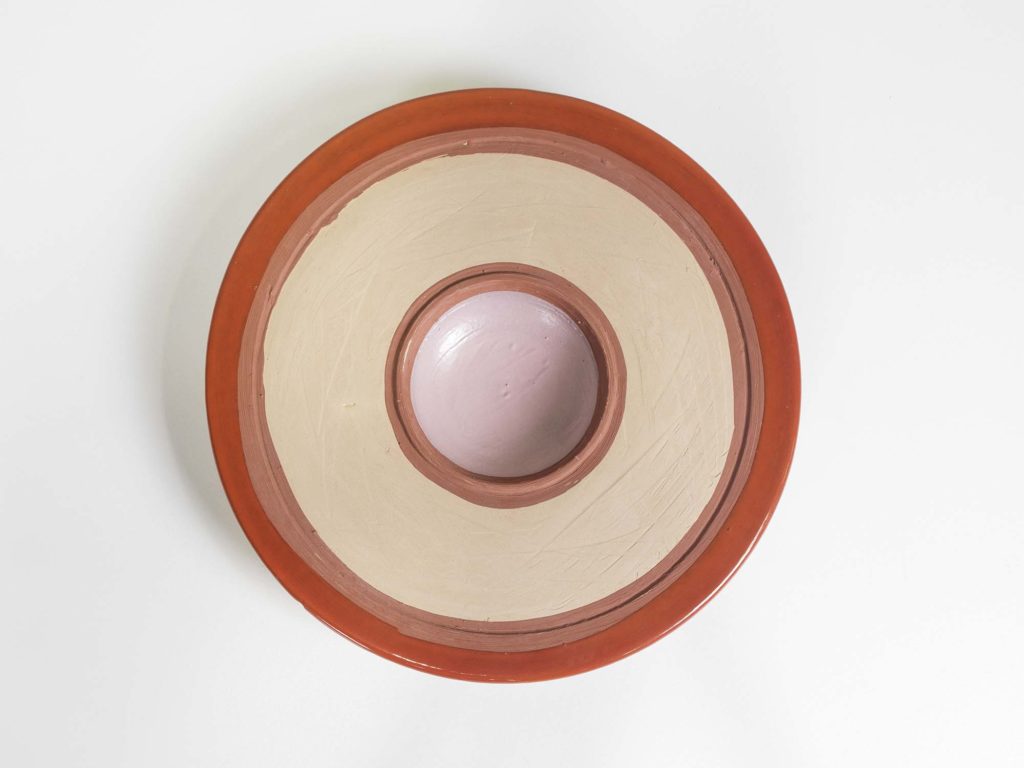
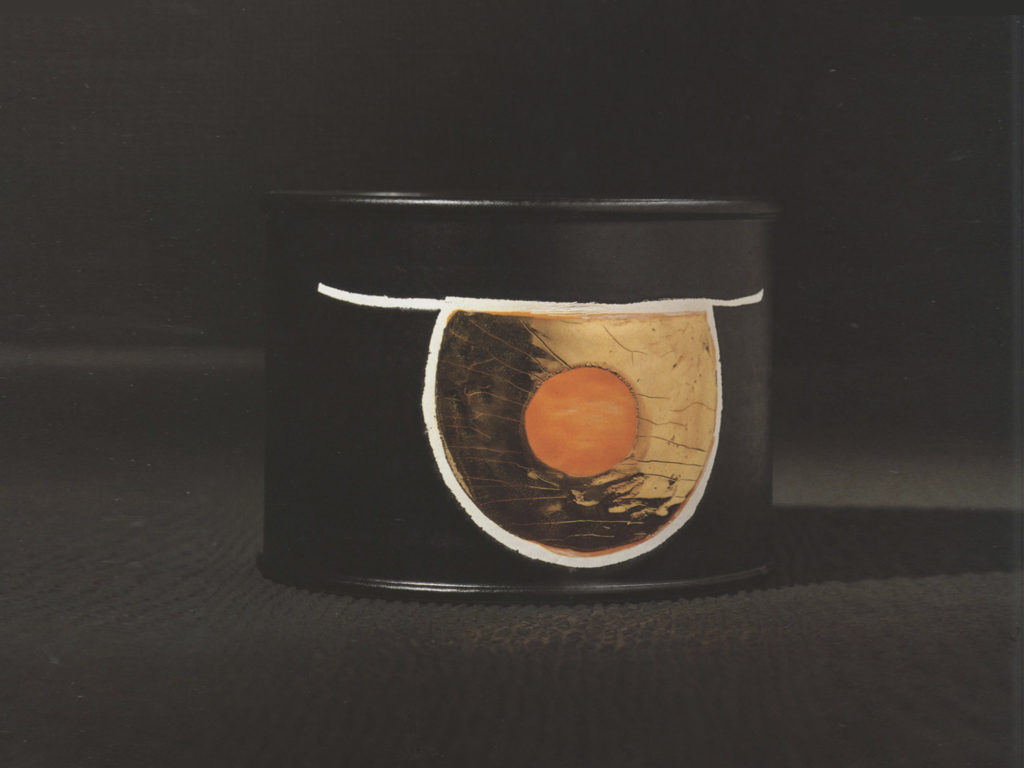
The melancholy hinted at here, always an undertow in Sottsass’s work, swelled into a powerful tide in 1962, when he fell gravely ill following travel in India. His patron Roberto Olivetti probably saved his life by offering to fly him to Stanford University in California for treatment. There he was diagnosed with nephritis, a kidney disorder, and slowly convalesced. Even during his frightening and disabling episode, he was characteristically creative. As he was recovering, together with his wife Fernanda (Nanda) Pivano, he collaged together a handmade journal called Room East 128 Chronicle (named for his hospital room). This was a catalytic period for Sottsass, a moment of reappraisal. Imagine him, now forty-five, confined to his bed: a world traveler who had achieved true creative freedom within the upper echelons of Italian industry. Now this flow of stimuli was cut off. All his inspiration had to come from within. And then, even as he was developing new ideas reflecting what he had seen in India, he was released into the beating heart of the west coast counterculture, just as it was cresting into a cultural wave. Nanda had plunged into this fertile scene and, once he was well enough, Sottsass eagerly followed in her wake. He channeled energies that would soon send shock waves around the world – psychedelia, drug culture, new fluid alternatives to everything that was “square.” It was an experience that shaped him profoundly, and permanently, as a creative force.[11]
The first concrete expressions of this new direction were a series of ceramics: totems, vessels and plates in which he channeled his sense of inner turmoil. Here was abstraction put to use: not as an academic formal exercise, but a way to communicate suffering, existential terror, and gratitude for renewed life. These contradictory emotions found expression in two series, which he entitled Tenebre and Offerings to Shiva, made in collaboration with the artisan firm Bitossi. The Tenebre, or “Ceramics of Darkness,” featured a palette which Sottsass likened to “the violet light of a hospital corridor,” with hand-painted renditions of the moon passing through its phases. (He also produced paintings at this time on the same theme.) This motif quite literally suggested itself to Sottsass in dreams he had while recuperating. In the context of the ceramics, the emblem summons multiple overlapping cycles of passage: the phases of the moon, of life and death, as well as the creation of the objects themselves, rising on the turning potter’s wheel, up from raw matter.
The Offerings to Shiva, a series of one hundred plates, are equally cosmic in their intention, seeming to depict celestial bodies in their motions, rising or setting over linear horizons. As the series title suggests, it draws on a deep well of religiosity and sacrifice. Among Sottsass’s sources were mandalas (transcendental diagrams) and the trays and other vessels used in pūjā ceremonies, undertaken to mark turnings in life, whether the beginning of a new day, the start of a business venture, a birth or marriage. He adopted these generative forms – grounded in an abstraction that predated modernism by millennia – in knowing juxtaposition to the saturnine Tenebre, not only conjuring the contradictory forces of life and death, sun and moon, light and darkness, but indicating that these oppositions were themselves part of a larger shared whole. The Hindu god Shiva, after all, is worshipped as the destroyer of the universe; but he does so only in order to re-create it.
Sottsass’s engagement with ceramics, along with his collaboration with Brugola, paved the way for his radical activities of the later 1960s and 1970s, often extrapolated in the context of “anti-design” groups (Global Tools, Studio Alchimia, and ultimately Memphis). Equally important, his independently produced ceramics and furniture marked a volte face in his ideas about production, and the purposes of design. At a time of historic upheaval, he described his own work in dramatic terms, characterizing his Yantra series of ceramics (1969), for example, as “spiritual diagrams, objects catalyzing perception, memoranda for the mental and psychic operations needed to shake off the paranoia of our everyday lives.”[12] In tune with this commitment to independence, Sottsass embraced more autonomous means of production. He recalled that after the war, when he was still operating in relation to prevailing modernism, he had “loathed craftsmanship. It was a symbol of richness, extreme skill and man exploitation. The new generation, the avant-garde, was very interested in mass production. I had even, at that time, written articles against the romanticism of craftsmanship and against this attitude which means that every man-made object is more precious, rare and exclusive as the Americans say.” By the 1960s, however, he had changed his mind, realizing that collaboration with artisans afforded him the opportunity for singular expressive acts. “Craftsmanship develops an awareness, a knowledge of life that we do not always find in industry.”[13]
What Sottsass had realized, by the end of the 1960s, was that he did not have to choose: he could navigate across the full range of productive possibilities that modern Italy offered, from the artisanal to the industrial, from Renzo Brugola’s atelier to the manufactories of Bitossi and Poltronova to the advanced factories of Olivetti. In a stunning piece of writing published in 1972, “The Planet as Festival,” Sottsass proclaimed this principle of absolute freedom in terms that seem to anticipate our own era of infinite technological networks. “Production problems no longer exist,” Sottsass declared.
We have all become artisan-artists, furnished with super-instruments for doing what we feel like by ourselves. We are also nomad-artists (or even not nomads), in that we are freed from the factory, the office, the supermarket, the bank, the street, the pavement, the tube, and the crystal entrance-hall. We are all nomad, or not nomad, artisan-artists because we possess this super-possibility to communicate, which always allows us to find out everything (about everyone and everything) and allows us to let everyone know everything about us, without any static centralized power, permanent or quasi-permanent, filtering it.[14]
Abstraction saw Sottsass through all of these contexts. He could apply it to any purpose, at any scale (a circle being a circle no matter its size) and in any material. It provided him the vector for structural systems; served as a vehicle for functionality; was a vessel for the most profound feelings. Indeed, it could do all of these things at once. This is what Sottsass demonstrated over the course of his long career, and above all in his formative work of the 1950s and ‘60s. Abstraction does not have to take you out of the world, to some higher plane. That is not its greatest magic. Rather, it is a means of exploring the world we all inhabit together: the ideal passport for the creative life.
[11] Barbara Radice, Ettore Sottsass, Jr.: A Critical Biography (London: Thames and Hudson, 1993), p. 62-65.
[12] Quoted in Sally Schöne, Auch der Turm von Babel was aus gabrannter Eder [And the Tower of Babel was also Made of Burned Earth] (Cologne: Wienand, 2011), p. 69.
[13] Quoted in Françoise Jollant-Kneebone, “Crafts and Industry, from Divorce to Honeymoon,” RSA Journal, Vol. 140, No. 5431 (July 1992), p. 500-514.
[14] Ettore Sottsass, Jr., “The Planet as a Festival,” Design Quarterly No. 89 (1973), p. 7-16.
This essay was originally published in exhibition catalogue Ettore Sottsass: 1953-1969, Friedman Benda, New York, NY, March 2020.
